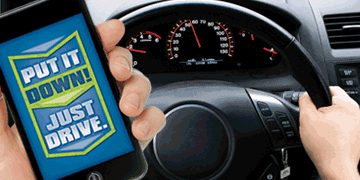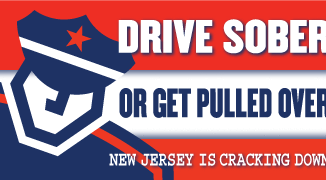
NEW JERSEY—Distracted driving is likely as dangerous and deadly as drunk driving.
That’s according to area police officials, state law enforcement agencies, and a New Jersey court that recently found a driver guilty of vehicular homicide due to distracted driving leading to a pedestrian’s death.
On Nov. 22, a jury in Monmouth County Superior Court, Freehold, found driver Alexandra Mansonet guilty of vehicular homicide after she was found responsible for a pedestrian’s death in Hazlet in September 2016.
Mansonet, who prosecutors proved had been replying to a text about dinner plans, said when she looked up she had no time to avoid crashing her Mercedes-Benz into a stopped Toyota Corolla ahead of her, which then plowed into a woman, 39-year-old Yuwen Wang, crossing the street.
Wang, who had been sent airborne in the collision, succumbed to her injuries a few days later at a New Brunswick hospital.
Mansonet, awaiting sentencing for vehicular homicide, faces up to 10 years in prison.
The Monmouth County court case is the first time that prosecutors applied a state law that went into effect in 2012 in which distracted driving penalties were elevated to the same level as punishments for drunken driving.
Mansonet likely won’t be alone. According to the state Division of Highway Safety and the state attorney general’s office, distracted driving accidents and summonses—and prosecutions—are on the rise.
Officers say not just cell phone use and texting but also eating and drinking, hair styling, applying makeup, and shaving divert drivers’ attention from driving safely and involve the use of at least one hand.
Police in the region area tell Pascack Press/Northern Valley Press that most of their holiday season traffic enforcement has focused on reducing drunk driving, or driving while intoxicated (DWI), which contributed to an increasing number of deaths nationwide last year, and that distracted driving joints it as a rising concern.
The National Highway Traffic Safety Administration (NHTSA) reported in December 2018 that 839 people lost their lives that year in traffic crashes involving a drunk driver, with the Christmas and New Year’s Day holiday periods constituting the deadliest period.
According to Eric Heitmann, director of the New Jersey Division of Highway Traffic Safety, these fatalities are preventable, and it’s the work of an ongoing “Drive Sober or Get Pulled Over” campaign to keep the number as close to zero as possible.
“People must remember that driving under the influence of any substance, be it drugs or alcohol, is deadly, illegal, and selfish behavior,” he said.
He warned that to promote traffic safety this holiday season, officers will be out in force looking for impaired drivers. Anyone driving under the influence during the campaign can count on being stopped and arrested, he said.
As of Dec. 1, New Jersey drivers convicted of a first-time or repeat drunk driving offense will be fined and must install ignition interlock devices on their vehicles—of terms ranging from three months to a year depending on the violation.
Once the device is installed, a driver must blow into its mouthpiece for testing before the vehicle can start. The device is programmed not to allow a vehicle to start if the driver blows above a .08 blood alcohol content (BAC), the state’s legal limit.
“Expanding the use of ignition interlock devices is just common sense,” said Gov. Phil Murphy, signing the law on Aug. 23.
He added, “We must deter drunk driving without negatively impacting individuals’ ability to take care of themselves or their families. License suspensions are an imperfect tool for accomplishing both aims, as they do not stop drunk drivers from getting behind the wheel and they can prevent ex-offenders from supporting their livelihoods.”
In contrast, he said, ignition interlock devices prevent drunk driving while allowing ex-offenders to support themselves and their families.
Greatly slowed reaction time, even following a call
In 2017, the AAA Foundation for Traffic Safety found in-vehicle communication systems “appear to increase the cognitive demand of a phone conversation, with drivers remaining distracted for up to 27 seconds after terminating a call.”
The study concluded “putting technology into vehicles seems to have had the opposite of its intended impact—increasing distraction rather than focusing a driver’s attention on the roadway.”
The AAA Foundation said increasing fines, installing roadway rumble strips to alert drivers when they accidentally leave their lanes, and disabling cell phones while driving would save lives.
Nationwide in 2018, 73 drivers involved in fatal crashes were classified as distracted, according to NHTSA data.
Distracted and drunk driving
Meanwhile, boosting enforcement is sending a strong message to drivers.
Based on increased enforcement efforts and anecdotal police reports distracted driving appears to becoming as much of a menace to public safety as drunk driving. Pascack Press/Northern Valley Press analyzed a recent police crackdown on impaired driving, mid-August to early September, finding greater numbers for distracted driving than previous reports.
Distracted driving summonses topped DWI arrests during the late summer enforcement period, and speeding and seat belt violations far exceeded distracted driving and DWI numbers.
According to the New Jersey Division of Highway Traffic Safety (DHTS), in a report available online, for the police mobilization Aug. 16–Sept. 2, there were 1,280 DWI arrests (alcohol or drug impaired), up from 1,172 in the previous fall’s campaign.
It said participating police agencies issued 6,603 speeding tickets and 3,304 seat belt tickets in the same period.
At the same time, it said, there were 1,786 summonses over distracted driving with phone use and texting.
Close to home, a number of area police departments tallied double digits on tickets for distracted driving: East Rutherford, 23; Teaneck, 20; Emerson, 15; Haworth, 12; and Mahwah, 11.
Wallington racked up the most tickets, 59, for distracted driving in the two-week period.
Police officers speak out
In Haworth, where reports showed 12 distracted driving summonses, Detective Sgt. Justin Fox said only one summons for cell phone use was written.
He said that the number listed might have included careless or reckless driving summonses.
Fox said overall 33 motor vehicle violations were written during the two weeks—many for vehicle equipment violations.
He said cell phone use behind the wheel “is there and prevalent. It’s an issue and another potential factor for a driver being distracted.”
According to Emerson Police Capt. Michael McDermott, “People are not paying attention to the road and therefore putting themselves and the public at risk.”
He said Emerson steps up enforcement for Drive Sober or Get Pulled Over even though his department doesn’t receive additional state grants for impaired driving enforcement, saying such funds are always welcome.
“Our officers are always looking for distracted drivers. While this [enforcement] may be the focus of a campaign, our job is to educate the public at all times,” he said.
McDermott, who said he did not have data at hand on distracted driving summonses in the borough for 2018 or 2019, explained officers take up positions around town where drivers can be easily observed in vehicles, then they just wait for cell phone/texting violators to pass by.
He said while officers might use discretion in giving tickets, the law has been on the books for a while and most drivers know it, though they often assume they’ll get away with it.
“It’s a pretty cut and dried violation with a cell phone if you’re holding it in your hands when you drive by us,” he said.
McDermott said distracted driving—whether due to cell phone use or texting—has receiving a lot more attention as a growing problem.
“I think we’ve brought more awareness to it and the awareness is much greater that it’s dangerous to drive that way. You’re taking more risks and putting others in danger by doing it,” he said.
McDermott explained most drivers likely don’t realize how far a car travels at 25 to 30 miles per hour when they put their eyes down for a few seconds to look at a phone or to text.
He said taking your eyes off the road even for a couple of seconds can cause a tragic and easily preventable accident.
Teaneck Police Lt. Tonya Balser agreed distracted driving “is a huge issue and plays a large role in crashes.”
She said during a three-week spring enforcement campaign, on distracted driving, officers in her department wrote 129 summonses for non-hands-free cellphone use.
“Our entire department is focused on it,” she said.
She added that incidents of distracted driving were “definitely increasing,” while drunk driving arrests were trending down.
“Distracted driving has become a much worse problem lately,” she said.
Wallington Police Chief Carmello Imbruglia said regular enforcement of distracted driving laws “keeps police officers very busy.”
He said his department was especially alert, topping all county police departments in writing distracted-driving summonses.
“On average the Wallington Police Department writes over 500 motor vehicle summonses a month. Most of the moving violations are for cell phone usage,” he told Pascack Press/Northern Valley Press.
He said his department issued 282 distracted-driving summonses in June and 328 for cell phone use in vehicles in July.
He added, “The distracted driving [cell phone] summonses are not only during the distracted driving campaign but also an everyday mission to make the roadways safe.”
Imbruglia said he agreed that distracted driving is similar to drunk driving in how it impairs a driver’s ability to drive safely. In some ways, he said, it was a worse phenomenon.
“When a driver is texting or talking on a cellphone the driver’s reaction time is considerably slower. They also take their eyes off the roadway and have to refocus on the road—which is a recipe for disaster,” he said.
According to Imbruglia, “When a driver is intoxicated you add 4 more feet to braking but when they are texting you add 70 feet. This is a huge increase in stopping distance and could be deadly,” he said.
Imbruglia urges drivers to take advantage of hands-free options.
“Put the phone down. The call or text is not more important than saving someone’s life,” he said.
Of the verdict against Mansonet, Imbruglia said, “While I am sure she did not want to harm anyone her moment of indiscretion cost the pedestrian her life.”



